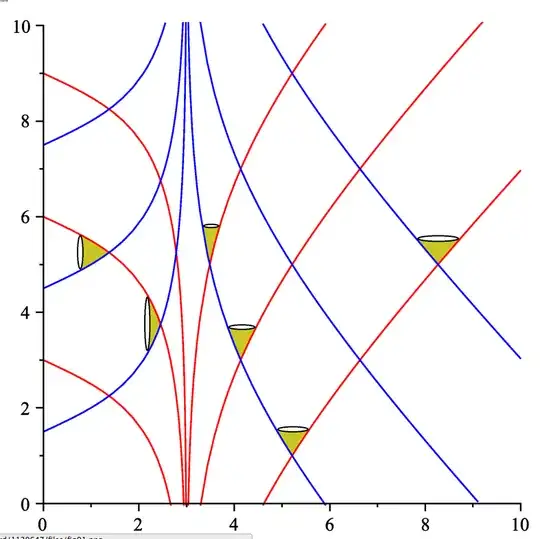Following is the picture copied from enter link description here, illustrating the future time cone inside the Schwarzschild horizon.

My question is, on the left side of $r=2M$, why must the time cone be left-oriented, but not right-oriented?
Following is the picture copied from enter link description here, illustrating the future time cone inside the Schwarzschild horizon.

My question is, on the left side of $r=2M$, why must the time cone be left-oriented, but not right-oriented?
The light cone separates intervals that are timelike from intervals that are spacelike. The interval is given by the Schwarzschild metric:
$$ ds^2 = -\left(1-\frac{r_s}{r}\right)dt^2 + \frac{dr^2}{\left(1-\frac{r_s}{r}\right)} + r^2 d\Omega^2 $$
If $ds^2 > 0$ the interval is spacelike, while if $ds^2 > 0$ the interval is timelike. For simplicity let's take only radial trajectories so $d\Omega = 0$ and the metric simplifies to:
$$ ds^2 = -\left(1-\frac{r_s}{r}\right)dt^2 + \frac{dr^2}{\left(1-\frac{r_s}{r}\right)} $$
Start outside the event horizon, $r > r_s$, and calculate the interval if we don't move in space but we do move in time. The interval is then:
$$ ds^2 = -\left(1-\frac{r_s}{r}\right)dt^2 $$
Outside the event horizon $r > r_s$ so $r_s/r < 1$ and the factor $(1 - r_s/r)$ is positive. So $ds^2$ is negative and this is a timelike interval as we'd expect. I won't do it because it should be obvious, but moving in space without moving in time gives $ds^2 > 0$ so this is a spacelike interval.
Now let's see what happens if we move inside the event horizon. This is the region where $r < r_s$, and that means that $r_s/r > 1$ and therefore that the factor $(1 - r_s/r)$ changes sign and becomes negative. So if as before we sit still in space, $dr = 0$, but move in time , $dt \ne 0$, we find that $ds^2 > 0$ so the interval is now spacelike not timelike. Similarly if we move in space but sit still in time we get $ds^2 < 0$ and this interval is timelike not spacelike.
So inside the event horizon movement in space looks like movement in time and vice versa. That's why the light cones have rotated by 90º.
You ask why the cones are left orientated i.e. pointing towards the singularity. The cones should be drawn pointing both ways, both inside and outside the event horizon, because they show what events lie in the future of the observer and what objects lie in the past. The question is really whether the observer can move in both directions. This is addressed in my answer to the question Why is a black hole black?, where I show that inside the event horizon to move to increasing $r$ requires a velocity faster than light.
Incidentally you can use the above approach to explain why the light cones close up as you approach the horizon. Just use the fact that on the light cone $ds = 0$ and you derive an expression for $dt/dr$ (the gradient in the diagram). This goes to infinity as $r \rightarrow r_s$.
Finally, I wouldn't attach too much significance to space behaving like time and vice versa. It is really just telling you that the Schwarzschild coordinates do not give a good description of the geometry inside the horizon.
The reason why is that you have a black hole and not a white hole. In a black hole, the future always points toward the singularity when you're inside the horizon.
A white hole is a time-reversed black hole, where, for objects inside the horizon, the past always begins at the singularity and the future always leads toward the horizon. It is perfectly consistent with the rules of general relativity to have white holes (and in fact, the time symmetry of the schwarzschild solution requires that the extended spacetime of pure schwarzschild contains both a black hole and a white hole), but any realistic matter with physically relevant boundary conditions will collapse to a black hole but never will collapse to a white hole. We therefore don't expect these solutions to exist in real life.